Justdafactsmaam
Addicted to Fun and Learning
- Joined
- Nov 13, 2023
- Messages
- 780
- Likes
- 551
Let’s just say you have my attentionCorrect but generating it is even simpler than using REW's auto EQ feature and takes less than 5 minutes.
Let’s just say you have my attentionCorrect but generating it is even simpler than using REW's auto EQ feature and takes less than 5 minutes.
Note that I didn't say you can solve resonances with "a little EQ", instead I said that sufficiently precise filters are required - that was actually the whole point.Ok so this obviously isn’t just a little EQ. This is more a DSP correction.
I will be putting a serious broad band bass trap to the test when I get back from China. Big project. One that both Ethan Winer and JJ think is an excellent idea.Note that I didn't say you can solve resonances with "a little EQ", instead I said that sufficiently precise filters are required - that was actually the whole point.
Also note that any digital EQ is a type of DSP correction. "DSP" just means "digital signal processing", and digital EQ is a type of that by its very definition.
Of course there are other types of DSP that are not EQ - things like dynamics processing, various spatial and modulation effects, etc...
Lastly, there are various implementations of digital EQ - they can be based on IIR filters or FIR filters, they can be presented as PEQ, GEQ, tone controls, DRC.... it is all still EQ, and we should in general select whichever suits the use-case best.
IMHO it is interesting that during the course of this discussion we never really focused on several things that are a very real limitation of using EQ for the purpose of room correction (rather than looking for issues with well understood concepts such as signal processing theory and Fourier transform).
For example, room resonances can slightly shift in frequency and shape when we change larger room furnishings, or with opening/closing of windows and doors, or with how full or empty the room is - see a few examples in this thread. This means that if we build very precise digital filters for one room configuration they will not be 100% valid for all expected room configurations and we may sometimes still get audible resonances. So we may need to build several correction filters and somehow switch between them when appropriate.
Room treatment may give a more consistent result in this case, but again - in very low frequencies (<100Hz) we can't rely on broadband bass traps, and tuned absorbers may again have issues targeting such 'drifting' room resonances. It would IMO be interesting to see this rigorously evaluated.
Secondly, tightly EQed response is usually only completely valid for a single location - other locations in the room will be compromised to some extent. This we can address well by optimizing the responses of multiple subs - I suggest to have a look at the study by Todd Welti from Harman.
Well executed room treatment should also result in a more consistent response at multiple location, but would likely cost a lot more and be more visually imposing than having 2-4 subs - and we'd still probably need to do some EQ in the end (though less than before).
Further, as stated before, EQ alone cannot adequately solve response dips/cancellations. Response dips can however usually be addressed by optimizing loudspeaker and subwoofer placement (see this post for some guidelines). In some cases multiple subwoofers may also be needed for best/flattest response.
Room treatment can also help to retrieve some energy in the response nulls, but significant (and expensive) treatment is usually needed - and we'd still probably need to do some EQ in the end (though less than before).
Also, EQ only solves resonances when they are activated by the audio system - if you play an acoustic instrument in the same room you'd still activate the original room resonances because EQ now doesn't apply. If this is an important consideration then there really is no alternative to optimizing room acoustics.
Lastly, EQ can't solve sources of resonances that are not room-related - e.g. a drum which you may have laying around that sympathetically rings when you play a specific frequency, or the whine of your faulty AC unit - which would both register in the waterfall measurement you try to make. To be fair, room treatment won't solve these either - the solution is to remove the drum from the room and to fix the AC unit.
So the way I see it you need the right tool for the problem you're trying to fix.
If we're just talking about listening to music at home at a single listening location then I'm quite sure most people would be amazed with what can be achieved by just using solid loudspeakers and a sub, with optimal placement to avoid response nulls, and using DSP to bring down remaining resonance peaks.
If it is a home theater with multiple seats then we need multiple subs with DSP-optimized responses (and likely some room treatment as well) to get a consistent bass response at all seats.
If we're instead talking about a live room in a recording studio then of course DSP is not a solution at all and we need a carefully designed and optimized room treatment (or better yet - a purpose-built room).
Good morning all.
When we sit relatively close to speakers and not listen at loud volumes, do we excite all room modes?
I know this is a very weird question but I am trying to understand if room issues become prevalent when you play loud.
Regards,
Alex

This is the original response, the filter (I currently actively use) and the response after filter in my room at the MLP for my left speaker:

Individual room resonances are often not sufficiently isolated to make it easy to see the effect of an individual EQ filter, but here is an example where that is the case. The after plot is the result of a single EQ filter, Fc 50.00 Hz, Gain -15.00 dB, Q 11.881 targeting a modal resonance with a 60 dB decay time of 1239 ms. When the zeroes of the filter correspond exactly to the poles of the resonance the resonance disappears, all that remains is the decay of the filter.

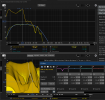
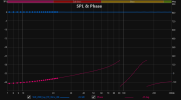
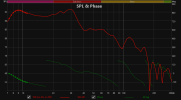
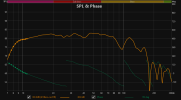
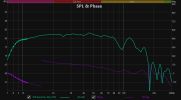
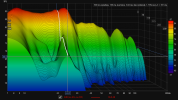
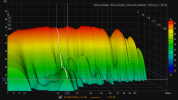

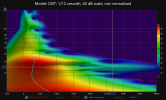

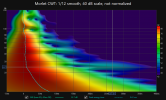
Look at it the other way around and consider your self lucky. Put a egg seater or silicone acoustic pack's between floor and speakers/sub's to move the 30 Hz resonance down and use self filter on it and you have cheap extension to 30 Hz.It is correct that room modes are not volume dependent as so many have said. But depending on your room, you might have some volume dependent "modes".
Yeah, that sounds like nonsense.
I have a very bouncy, and sagging, 100 year old floor, which is pretty much a 30 hz drumhead. I also have a 30 hz room mode from the size of my room. To make matters worse, at higher SPLs, my floor then adds a 129 hz, like a huge sudden spike! It will go from very small to huge in a 3db range. That is way more annoying than the 30 hz, for sure. So as I, in my particular room, turn up the volume, the 30 mode gets much, much worse and eventually a new "mode" shows up at 129.
Lower volume does matter in my situation.
So modes that are from your room dimensions, not volume dependent. Anything that shows up from shaking/vibration, that will be volume dependent. And might LOOK like a room mode when you measure.
The best way I found to deal with this, in terms of measurement, is to use both sweeps and white noise. The sweep shows classic room modes, the white noise will show that plus additional modes from shaking/vibration. I probably have an example of my 129 problem at home, and will post that later when I get time.
Is it at all possible to design a sort of modal filter derivative which will correspond to the exact complex conjugate "zeros" of the resonance instead of its poles to eliminate the dips?When the zeroes of the filter correspond exactly to the poles of the resonance the resonance disappears
Both. Low frequency room modes behave like minimum phase phenomena. Correct the frequency response magnitude automatically correct the phase.Are you saying it’s the speaker not the room?
Both. Perceiving a tone is one thing, perceiving a bass transient is another. In my experience most complaints about the bass in small rooms is that it is "boomy" implying a time-domain problem. Fortunately prominent low frequency room resonances behave as minimum-phase phenomena, meaning that parametric equalization addressing those peaks will tame the ringing as well. But there is more: In Section 8.3 in my book "Do We Hear the Spectral Bump, the Temporal Ringing or Both?" addresses the fundamental issue. It turns out, thanks to serious research by some serious Europeans, that we respond to the bump, not the ringing - in spite of what we think we hear. Years before, Sean Olive and I published a paper showing that this was true at frequencies above about 200 Hz as well.
Bass is more than what's below 100 Hz and the area 80-300 Hz is actually the most sensitive area. Therefore I would advice to always show up to at least 300 Hz.Subwoofer's response at the rear (near the backwall) couch main listening position in my room uses quite a few more filters:
View attachment 342827 View attachment 342828 View attachment 342829
4 ~vs~ 8 minimum phase filters + simple inverse phase all pass filter
SPL & Phase:
View attachment 342830 View attachment 342831 View attachment 342832
Waterfall:
View attachment 342820 View attachment 342821 View attachment 342822
Morlet CWT:
View attachment 342824 View attachment 342825 View attachment 342826
Bass is more than what's below 100 Hz and the area 80-300 Hz is actually the most sensitive area. Therefore I would advice to always show up to at least 300 Hz.
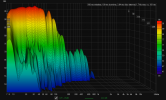




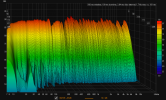
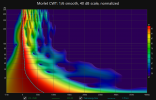



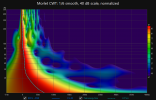

Dr. Geddes also agreed (conceded?) that LF behaviors in rooms were likely "nearly" minimum phase.
Multiple Small Subs - Geddes Approach
As long as one dimension is longer than the wavelength of interest, then there is a mixture of non-minimum phase which makes the whole analysis and measurement non-minimum phase. Why? And why is the limit exactly at one wavelength? A similar question goes to john k.: Why is the transfer...www.diyaudio.com
View attachment 342888
I don’t think this is universally agreed upon and so far every waterfall plot I have seen suggests otherwise.Both. Low frequency room modes behave like minimum phase phenomena. Correct the frequency response magnitude automatically correct the phase.
Experts can have different opinions, and I'll leave it at that.I don’t think this is universally agreed upon and so far every waterfall plot I have seen suggests otherwise.
And I’m no expert. Just trying to pick my experts carefully.Experts can have different opinions, and I'll leave it at that.
The decay looks the same on those pictures??The posted waterfall plots show exactly what I was talking about. After flattening the initial attack with EQ the room mode frequencies have a substantially slower decay than the adjacent frequencies. Ringing
